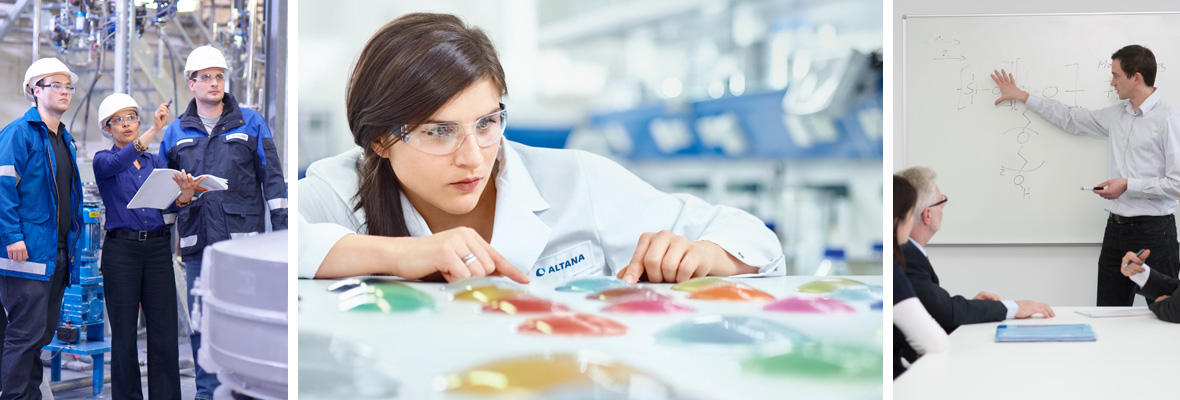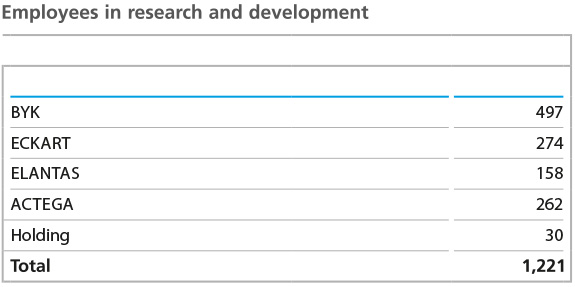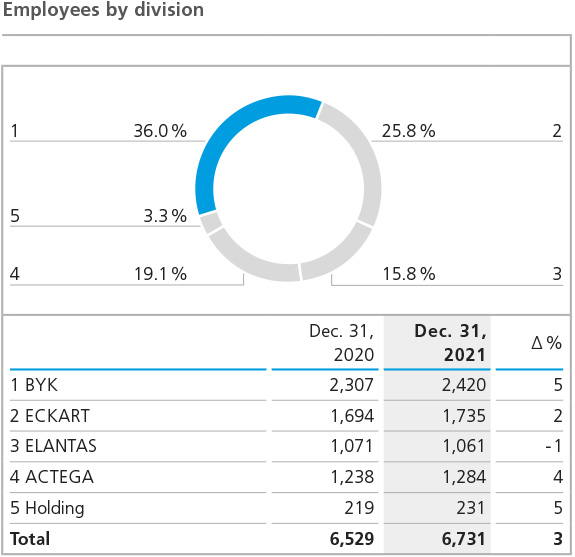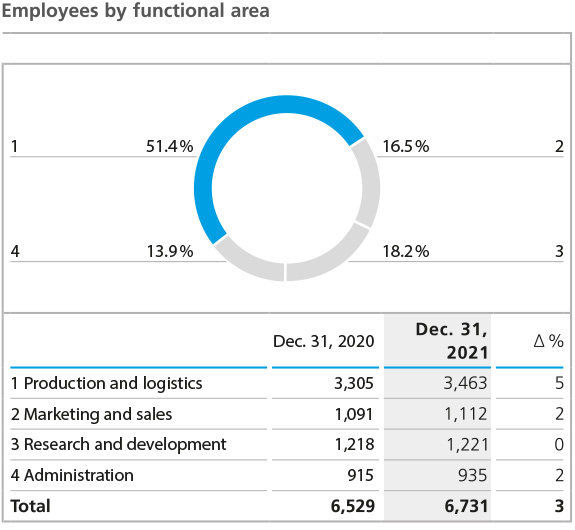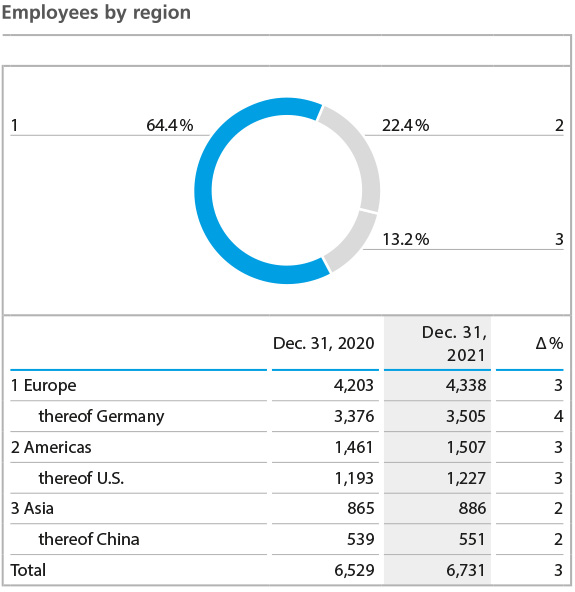Letter from the Management Board | About This Report | Sustainability Management | Corporate Bodies and Management | Report of the Supervisory Board | Climate Protection at ALTANA | Group Management Report | Products | Safety and Health | Environment | Human Resources | Social Commitment | Consolidated Financial Statements (condensed version) | Multi-Year Overview | Global Compact: Communication on Progress (COP) | ALTANA worldwide | List of Full Ownership | Overview - About This Report | Contact
Innovation
As a specialty chemicals company, innovations are an important factor for ALTANA, enabling us to offer our customers new, competitive solutions and at the same time to meet current requirements regarding performance profile, costs, environmental protection, and sustainability. Thanks to close cooperation with our customers, we are able to identify global technology trends at an early stage and to be immediately involved in new development fields. This enables us to develop tailored solutions quickly and reliably. We build on existing competencies, on the one hand, and gain access to new ones on the other, in order to continuously adapt our product portfolio to market and customer needs. There is also great potential to combine our competencies across the divisions to establish innovative solutions on the market more quickly and efficiently. To this end, our researchers and developers have access to the latest analytical methods in our chemical laboratories and application-technology test laboratories. Numerous awards from our customers underscore our success as an innovative solutions provider.
In addition to the activities in the business divisions, selected innovations are initiated and coordinated at the ALTANA level, aimed at tapping new business fields and absorbing technology and market trends. The basis for these innovations are the strong competencies of the divisions along the entire value chain as well as the synergies that arise between the divisions. For the design of new innovation areas, we use three different but thematically complementary approaches: the ALTANA Institute, our technology platforms, and corporate venturing.
With the help of the ALTANA Institute, external networks and close cooperation with universities and research institutes around the world are used to harness outside impetus. Here we cooperate in the area of basic research on topics that form the foundation for further more application-oriented internal research and development activities. In addition to the technology transfers of the first completed projects to the divisions, this year also saw the establishment of a new international research cooperation with the University of Haute-Alsace in France and a collaboration with Friedrich Schiller University in Jena.
As in 2020, in the 2021 fiscal year ALTANA’s investments in technology platforms exceeded the previous year’s figures. This once again demonstrates the progressive expansion of investments based on targeted customer cooperation.
Despite the pandemic-related restrictions both in terms of customer support and expansion of the customer base, the Printed Electronics innovation platform, which has been integrated into ELANTAS, succeeded in generating initial sales, building up a solid sales pipeline on this basis and acquiring new business.
A versatile product portfolio for 3D printing was developed as part of the Cubic Ink technology platform. In close cooperation with dp polar GmbH, in which ALTANA holds a stake, this ink portfolio is used in development partnerships with customers to provide efficient and sustainable solutions through innovative polar printing technology. In addition to polar printing technology, the ink portfolio was expanded to include inks for SLA (stereolithography printing), a standard process in the 3D printing industry. These products were presented to the market for the first time at Formnext, the leading international trade fair for additive manufacturing technologies, in 2021.
The laser transfer technology platform HELIOSONIC also made progress. It expanded its pigment portfolio and was thus able to enter into more strategic development partnerships beyond the graphic arts industry. This year, further feasibility studies were carried out in the security printing and electronics sectors. In addition, the design and construction of a roll-to-roll printing machine was completed and went into operation at the newly occupied site in Rüsselsheim.
Thanks to the close cooperation between the central departments Corporate Innovation and Corporate Venturing, ALTANA can continuously examine technology and market potential and enter new attractive markets by means of targeted investments in innovative technology companies. In this context, ALTANA again increased its investment in the company TAU ACT GmbH, Berlin, in the 2021 fiscal year.
The basis for our innovative strength is an open and dynamic corporate culture that gives the 1,221 employees in our worldwide research and development centers freedom for creative and entrepreneurial action. The equipment in our development centers enables our employees to turn their ideas into market-ready solutions. In 2021, our research and development expenses increased to € 179.7 million, compared to € 163.4 million in the previous year. We fell slightly short of the budgeted figure for 2021 due to ongoing pandemic-related uncertainties. The reduced share of sales accounted for by research and development expenses of 6.7% (previous year: 7.5%) is due in particular to the extraordinary increase in sales. In general, our expenditures are related to the achievement of important milestones, the implementation of individual customer requirements in future innovative products, and the long-term orientation of our innovation activities.
At the end of 2021, the companies of the ALTANA Group employed 6,731 people worldwide (previous year: 6,529). The increase of 202 persons or 3% compared to the previous year is due on the one hand to acquisitions in the ECKART (+36 employees) and ACTEGA (+12 employees) divisions, and on the other to increased personnel requirements to cover the increased demand (especially in the BYK division).
In the BYK division, the number of employees rose by 113 to 2,420 (previous year: 2,307). The workforce mainly increased in production areas of the BYK companies in Germany and the U.S. due to the sharp rise in production volumes.
In the ECKART division, staff numbers increased by 41 to 1,735 in the course of 2021 (previous year: 1,694). The changes mainly concerned production and are almost exclusively attributable to the acquisition of the business activities of TLS Technik GmbH & Co. Spezialpulver KG in Bitterfeld.
ELANTAS recorded a slight decline of 10 employees to 1,061 (previous year: 1,071). Most of this decrease concerns employees in administrative areas.
In the ACTEGA division, staff numbers rose by 46 to 1,284 in the course of the year (previous year: 1,238). One driver was the acquisition of the Henkel company’s closure materials business, which led to an increase of 12 employees. In addition, staff were added in sales and administrative areas, mainly in the field of information technology.
In the Group’s holding companies, the headcount rose by 12 to 231 in the past fiscal year (prior year: 219). The largest increase was recorded at ALTANA Management Services GmbH, with 8 additional employees.
The functional structure of the workforce did not change significantly in the 2021 fiscal year. With 51% or 3,463 people (previous year: 3,305), most of the employees continued to work in production. The research and development workforce increased only slightly by 3 to 1,221 in 2021 (previous year: 1,218). In marketing and sales, the number of employees increased by a total of 21 to 1,112 in 2021 (previous year: 1,091). In the year under review, 935 people were employed in administration (previous year: 915).
There were also only minor shifts in the regional structure in 2021 compared to the previous year. With 4,338 employees (previous year: 4,203), the European Group companies continued to account for by far the largest share of staff. At the end of the year, 3,505 people (previous year: 3,376) were employed in Germany, the majority at the largest manufacturing and development sites of the ECKART and BYK divisions in Hartenstein and Wesel, respectively. The workforce in the Americas rose by 46 to 1,507 at the end of 2021 (previous year: 1,461). The increase was primarily in North American companies. The number of people employed by Asian Group companies grew from 865 in the previous year to 886 in 2021, with the largest increase in China.
At the end of the 2021 fiscal year, 1,757 women and 4,974 men worked for ALTANA. 89% of all employees had an unlimited and 11% a limited employment contract on the balance sheet date. This ratio was virtually the same for both genders. 76% of the female employees worked fulltime and 24 % part-time at the end of 2021. Among male employees, 98% worked full-time. Apart from its own employees,136 people from employment agencies worked for the ALTANA Group on December 31, 2021.
The people at ALTANA are the most important key to our success. ALTANA continues to face international competition for specialists and managers. As a result, the importance of dedicated personnel development and succession planning will increase further in the coming years, also in connection with the demographic development.
In 2021, ALTANA came a great deal closer to achieving the goals set in the “HR Transformation” project. The project is aimed at driving forward the digitization of the HR landscape, promoting employees more comprehensively across divisions and national borders, and creating an international leadership and HR culture.
A very important step toward digitization in human resources was taken in 2021 with the global rollout of the Employee Central module of SAP SuccessFactors, a new, globally available system for the administration of organizational and HR master data in the ALTANA Group. This makes it possible for the first time to offer extended self-service functionalities in the area of human resources. The option now available in most countries enabling employees to enter and maintain their data directly in the system is just one example; in the future, digital learning opportunities, further training measures, annual appraisals, talent conferences, and much more will become even more important. Building on the structural information of Employee Central, further SuccessFactors modules will gradually complete the socalled employee lifecycle toward system-supported interaction between employees, managers, and HR.
All new employees in the ALTANA Group who are registered in SuccessFactors now automatically receive an IT account, which is a prerequisite for access to the ALTANA network. It is therefore possible to provide all employees in the company, for example in production, with digital services.
With this investment, ALTANA’s management is underscoring its commitment to driving forward the digitization of ALTANA. Employee Central is a milestone in the global digitization of our HR landscape and the starting point for creating a unified employee experience.
In order to create the best possible conditions for all employees in the future with regard to talent management and personnel development, we introduced the new ALTANA Talent Cycle in 2021. The Talent Cycle combines a revised version of the previous compass dialog (annual employee review) and the new People and Talent Conferences with a completely digital platform – also provided by SAP SuccessFactors. This is a global, digital, and standardized process that enables all employees to receive clear feedback on the competencies that are important to ALTANA and to exchange views with their manager in a structured and continuous manner. Personal strengths and areas for development are identified in a comprehensible way. With the help of this assessment of competencies and potential, personal development can be managed and cooperation between employees and their managers improved. Talent conferences at the local, divisional, and global level serve to calibrate performance and potential assessments by managers and form the basis for future career and succession planning.
In the area of Compensation & Benefits, the attractiveness of the employee participation program ALTANA Profit Participation Rights was once again enhanced in 2021 by raising the employer allowance and the investment opportunities in Germany. ALTANA had issued the profit-sharing rights for the first time in 2010, thus creating an opportunity for employees to participate in the future success of the Group by acquiring an entitlement to an interest payment dependent on ALTANA’s success. Due to the attractive conditions, an average of around 40 percent of those entitled have participated in recent years.
Environment and Safety
Occupational safety and environmentally compatible management are key components of ALTANA’s corporate strategy and are becoming increasingly important. The ALTANA Group measures progress in the area of environmental protection using specific key figures, such as the consumption of natural gas and electricity as energy sources and the resulting greenhouse gas emissions, and in the area of safety with the help of accident figures.
In terms of environmental protection, our goal is to continuously reduce energy consumption at all of our sites and in all areas and to promote the use of energy from renewable sources in order to achieve climate neutrality for the ALTANA Group by 2025. ALTANA plans to compensate for the greenhouse gas emissions that cannot be avoided by 2025 by financing equivalent climate protection projects. In the field of safety, the primary objective is to reduce the number of accidents.
The issue of safety is a top priority at ALTANA. ALTANA ensures continuous improvement in the safety of its employees by means of various technical and organizational measures tailored to the production conditions at the sites and to the laws and regulations that apply there. To achieve a uniform safety culture, ALTANA also relies on targeted employee training programs. All of our worldwide sites have established their own safety organization, which is responsible, among other things, for complying with all local occupational safety regulations, for training and education measures, and for recording and evaluating accidents. Throughout the Group, the Work Accident Indicator (WAI) serves as the central key performance indicator for recording and evaluating the development of occupational safety at all sites on the basis of reported accidents with lost work days. Three key figures are defined for better comparability: WAI 1 refers to the number of reported occupational accidents with lost work time of one day or more per million working hours. WAI 2 comprises the number of reported occupational accidents with lost work time of more than three days per million working hours. And WAI 3 represents the number of lost work days due to reported occupational accidents per million working hours.
ALTANA determines the working hours on the basis of the actual hours worked. If such recording is not possible, a qualified estimate of the average hours worked is made. Accidents are recorded directly on site and reported to a defined group of persons within 48 hours. On a quarterly basis, the reported accidents with lost work days are evaluated in a global IT system. Subsequently, the evaluations are made available to all responsible persons (such as the Management Board, division presidents, managing directors, and EH&S experts). On the basis of this data, ALTANA’s Management Board, together with the EH&S department, sets target values for the three WAIs for each year, which apply equally to all companies of the ALTANA Group.
For 2021, ALTANA again lowered the target values for all three accident indicators (WAI 1: 2.5; WAI 2: 1.7; and WAI 3: 30.0), once again emphasizing how important occupational safety is for the Group. In the year under review, despite the high workload at our companies, we succeeded in achieving these target values. Globally, 24 accidents with lost work days were reported at ALTANA, 5 more than in the previous year. Based on the hours worked, the WAI values are as follows: WAI 1: 2.1 (previous year: 1.8); WAI 2: 1.5 (previous year: 1.0); and WAI 3: 25.2 (previous year: 19.5).
ALTANA managed to keep the occupational accidents at a low level by enhancing employees’ safety awareness and the Group’s safety culture as a whole. The further development and implementation of technical and organizational measures as well as behavior-based safety training are intended to lead to safe action in every situation.
ALTANA has also been addressing the issue of energy efficiency and the associated greenhouse gas emissions for several years. In addition to absolute values, energy consumption is set in relation to the quantity of finished goods that are produced. ALTANA establishes annual reduction targets for energy consumption in relation to the quantity of finished goods produced. The recording and calculation of emissions relates, as Scope 1, to direct greenhouse gas emissions from emission sources owned or controlled by the Group. These include, for example, the combustion of primary energy sources in the course of heat generation and fuel consumption in the company’s own vehicle fleet at some sites. Scope 2 includes indirect greenhouse gas emissions from the performance-related purchase of electricity. They are recorded and calculated in accordance with the standard “A Corporate Accounting and Reporting Standard – Revised Edition” of the Greenhouse Gas Protocol initiative. The data are reported in the document “Facts and Figures on Sustainability 2021.” The energy consumption of all production sites included in the scope of consolidation is recorded and evaluated in a global reporting system. The CO2 equivalents for Scope 2 are calculated based on conversion factors (g CO2/ kWh) defined by the International Energy Agency (IEA) in line with the currently published values (2019) for the location-based method and with the aid of emission factors of the electricity supplier or an individual electricity product for the marketbased method. For Scope 1, the conversion factors from the Intergovernmental Panel on Climate Change (IPCC) are used.
Consumption is generally verified by the companies by means of bills. If this is not possible for the last two months of the reporting year, the companies first make a qualified estimate of the values. As a result, in the following year – as soon as all bills are available – the prior-year figure may still be adjusted retrospectively. In 2021, ALTANA had a total energy consumption of 743,304 MWh (previous year: 668,493 MWh) due to the sharp increase in the volume of finished goods produced. The main energy sources were natural gas (418,428 MWh) and electricity (276,843 MWh). ALTANA set a target value of 1.24 MWh /t for the specific energy parameter – based on one ton of finished goods – for 2021, and in the reporting period even fell significantly below this value at 1.21 MWh /t – an important step on the way to energy transformation. This resulted in a total of 102,851 tons of CO2 equivalents. Of this amount, 101,495 tons of CO2 equivalents belong to Scope 1. ALTANA offsets 33,351 tons of CO2 equivalents of Scope 1 emissions by investing in certified offset projects. The project in question is the Kinnaur Hydropower Plant project on the Satluj River in the Himachal Pradesh region of India.
For the purchased electricity of 276,843 MWh, the same amount of Guarantees of Origin was acquired in accordance with recognized quality standards (for example, CoO for Europe, GREEN-E for the U.S., and IREC for China) and through a German PPA (Power Purchase Agreement). This is electricity that is generated from renewable energies and whose origin is made transparent by means of a Guarantee of Origin. ALTANA plans to finalize the decommissioning of these Guarantees of Origin for 2021 in April, as in the previous year. This means that ALTANA’s electricity purchases cause zero CO2 emissions according to the market-based method. As a result, 69,500 tons of CO2 equivalents (68,144 tons for Scope 1 and 1,356 tons for Scope 2 from the purchase of electricity, steam, district heating, and compressed air according to the market-based method) from unavoidable greenhouse gas emissions were caused that were not offset by compensation.
